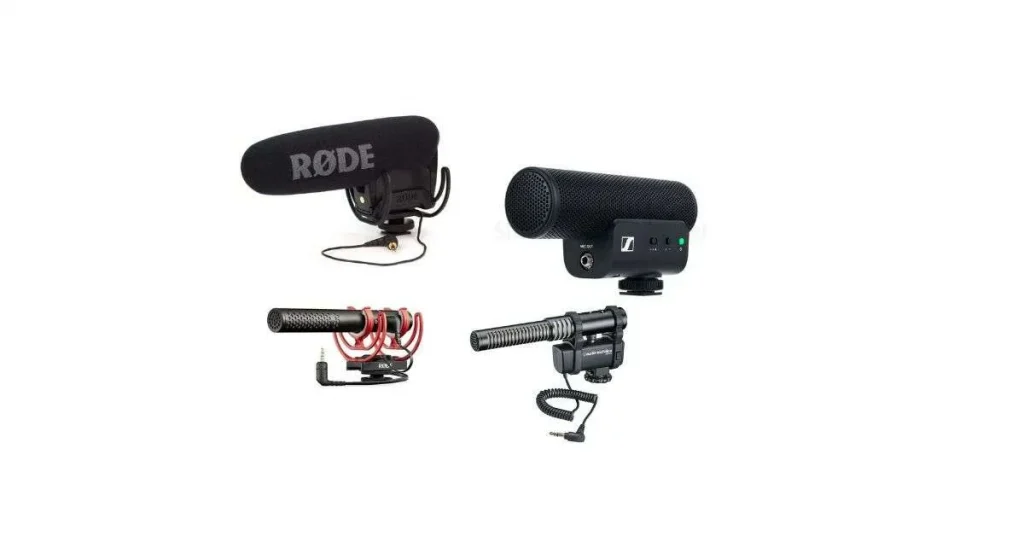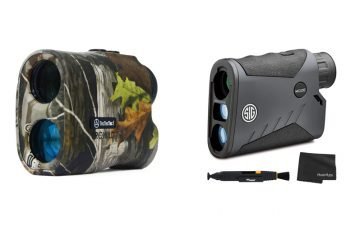If you are an avid videographer, or a media producer, there must have definitely been instances when you have felt like the sound quality doesn’t do justice for the video taken by your high resolution camera. The cameras, even the best and the most expensive ones, have a lot of excellent features, but they are more driven towards the picture and video quality, rather than sound. And, this makes it important for media producers to get a separate DSLR microphone to get the best possible audio along with a great picture quality.
If you are intending to shoot anything professional, you have to know that it isn’t possible without a DSLR microphone. Almost all of the DSLR cameras have a built-in microphone, but unfortunatley, they are far from reliable giving you a bare minimum. So, sooner or later, a DSLR microphone is absolutely necessary. But, with a wide variety of DSLR microphones available in the market, offering different features, it is very bewildering to pick out the best and the most suited DSLR microphones for you. But, don’t worry, we got you covered!
In this article, we will be taking a deeper dive into the best DSLR microphones in 2023 along with their specifications, and reasons to consider purchasing them. This will hopefully, give you an insight on which DSLR microphone you might actually want for your next big project.
Tips for buying the best DSLR microphones
Before taking a leap right at the top picks, let’s take a quick look at all the necessary criterias you should take into consideration before deciding on a DSLR microphone to buy. These are some of the essentials a DSLR microphone must have.
Type of Mic
There are several mic types available for DSLR cameras, and they all serve different functions. They are usually categorized on the basis of the way they record audio, their connection, their shapes, usage, and even according to their polar pattern.
Dynamic mics, are the ones that are categorized on the basis pf how microphones sound. These kind of mics make use of electromagnetism in order to convert sound into electrical signals. These are very versatile and are generally affordable.
The condenser mics are generally more accurate and offer amazing audio quality in comparison to the previously discussed dynamic mics. These are the expensive types and can be omnidirectional or bidirectional.
The ShotGun Mics literally look like a shotgun barrel. These kind of mics are highly directional and amazing at separating the sound sources and focusing on one at a time. The off-camera mics are more directional than the on-camera ones. In order to select the sensitivity better, it is necessary for the pickup pattern, that can be super cardioid, hyper-cardioid or ultra-cardioid.
Lavalier mics are usually called the lapelmics or clip-on mics, and these are designed in a way to be attached to the broadcaster’s or reporter’s clothes directly. These are mostly used for films and other broadcastings, that require recorded dialogues. Appropriate distance of about 20-30cm from the mouth is required is required for this mouse to give clear audio.
Polar Pattern
Polar pattern of a microphone is the way it picks up sound from the surrounding. For instance, some microphones pick up sound from all directions simultaneously, while others take in from a single direction depending upon their type.
A cardioid pattern, also called a “heart-shaped” pattern, is commonly used in picking up vocals or speech. Mics with the cardioid pattern directionality lets you only “hear” sounds from the front, and some sound from the sound, and are often used for recording music.
Similarly, a super cardioid polar pattern bears a narrower pickup pattern than the cardioid one, and provides a more significant rejection of background sound. These type of microphones directly pick up sound from the rear, and are ideal for capturing single sound sources in a noisy atmosphere.
In a figure-eight polar pattern, there are microphones in a bi-directional pattern. These microphones pick up sound from both the front and back,and are popular among podcasters.
In a similar manner, microphones with multidirectional pattern are also available. These kind of microphones pick up sounds from all directions, perfect for recording groups or crowds. These kind of microphones are commonly used in live performances, to recreate the room’s sound, but these might have high feedback sensitivity.
Frequency Response
With the different microphones available, these all react and response differently to the frequency type. While some respond better to lower frequencies, some react better to higher ones. A frequency response of a microphone is the range of detectable frequency, which are typically between 20Hz to 20KHz.
This makes it important to select a microphone that perform appropriately for the function you require, and about what you will be recording. For instance, a microphone like a dynamic mic that performs better at lower frequencies, may lose credibility if exposed to bass or drum recordings
Filters
There are a lot of filters available in the market too. Like, the high pass filters may be useful when it comes to getting rid of unwanted noise from your recordings.
For any microphone, Low-frequency traffic noise is the most common source of ambient noise. And, if your microphone contains a high pass filter switch, you don’t need to worry about these noises.
Mounting
The way a microphone needs to be mounted, is also an important consideration when buying a microphone for your DSLR camera. This will usually be overlooked, if you are mounting the microphone directly on the camera. In its place, a robust shock mount prevents handling noises from compromising the audio quality whenever the camera is moving.
Using a camera-compatible shock mount will prevent the creaks that can be caused by changes or movement of the camera operator.
Power
While batteries power some microphones, others get their power from the camera’s built-in battery. In addition, outdoor video filming necessitates careful consideration of your power alternatives.
In this situation, it’s preferable to utilize a battery-powered microphone to reduce the burden on your camera’s battery.
Top 6 Picks for the Best DSLR microphones in 2023
Below are our top picks for the best DSLR microphones in 2023. Let’s take a look.
1. Rode Video Mic Pro DSLR Microphone – Our Top Pick
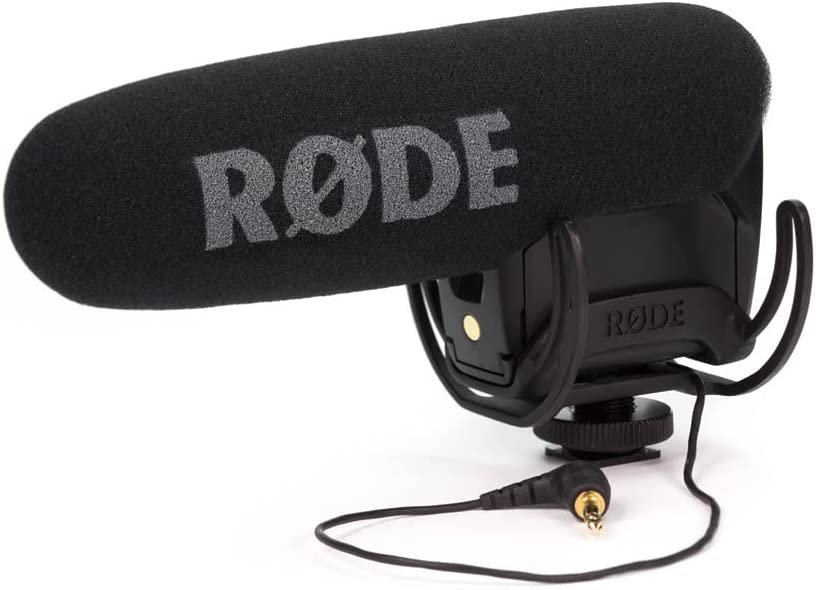
The Rode VideoMic Pro is undeniably one of the best DSLR microphones in 2023. It is small, compact and lightweight and this external microphone gives you pro-level quality sound. The compactness of these microphones make it very useful for people who are mostly outdoors.
Not just that, the Rode VideoMic Pro is also designed to capture sound from various sources. This feature makes it very easy to record two-person interviews plus backup recordings. On top of that, the battery life is also quite good so you don’t have to constantly worry about the battery running out when you’re on the go. The internal storage of the Rode Wireless Go II is also pretty impressive, for it can keep up to about 24 hours of compressed sound or 7 hours of uncompressed recordings.
The materiality of this action microphone speakers is also made fully of solid materials, making the camera microphone attachment one of the best in 2023 for outdoor photographers. Plus, it’s high-pass filter optimizes in integrating high pass filter that reduces background noises considerably in outdoor settings.
Specifications
| Acoustic Principle | Line Gradient |
| Capsule | 0.50” |
| Frequency Range | 40Hz – 20kHz |
| Maximum SPL | 134dB SPL |
| Maximum Output Level | 6.9mV (@ 1kHz 1% THD into 1KΩ load) |
| Sensitivity | -32.0dB re 1 Volt/Pascal (20.00mV @ 94dB SPL) +/- 2dB @1kHz |
| Polar Pattern | Supercardioid |
| High Pass Filter Frequency | 80 Hz |
Pros and Cons of Rode DSLR Microphone
2. Rode Video Mic NTG

The Rode Video Mic NTG id basically a highly compact and versatile shotgun delivering an excellent audio quality in any kind of atmosphere.
On top of that, it can be multipurpose by using it with a smartphone, other kind of portable audio recorders and even desktops, especially for interviews and recording podcasts. So, it is absolutely flexible.
The VideoMic NTG makes great usage of the acoustic perforations, present along the shaft of the microphone instead of the linear slots seen in a conventional, market-popular shotgun mic and on-camera microphones. What this change in design does is that it gives a relatively higher degree of transparent audio.
The VideoMic NTG also has a very flat frequency response range, a highly directional supercardioid pattern, plus extremely low self-noise emitted, and small, compactly designed and small, compact that delivers great.
Specifications
| Acoustic Principle | Pressure gradient electric condenser |
| Output Impedance | 100 |
| Frequency Range | 20Hz – 20kHz |
| Frequency Response | 35Hz – 18kHz ± 3dB |
| Signal-to-Noise Ratio | 79dBA |
| Sensitivity | -26 dB re 1V/Pa (50mV @94dB SPL) ± 1Db @ 1kHz |
| Polar Pattern | Supercardioid |
| High Pass Filter Frequency | 75Hz, 150Hz |
| Output Connection | 3.5mm auto-sensing USB-C |
Pros and Cons of Rode DSLR Microphone
3. Sennheiser MKE 400 DSLR Microphone
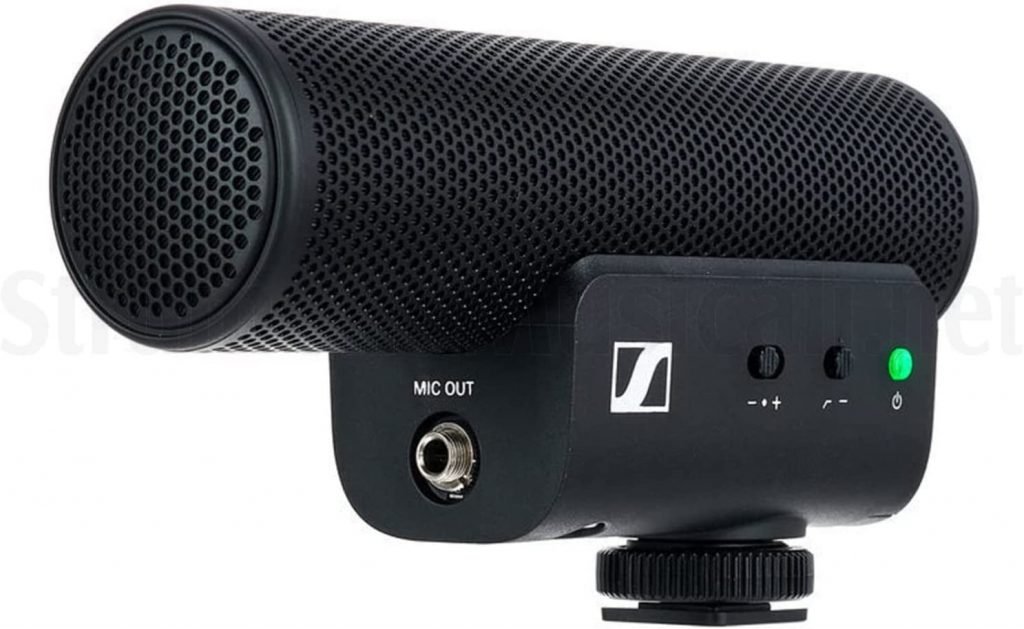
Specifications
| Frequency Response | 50 to 20000 Hz |
| Output Power | 105 (headphone impedance 16 ()), 70 mW (headphone impedance 32 Ω) |
| Maximum Sound Pressure Level | 132Db SPL |
| Pick-up Pattern | Super Cardioid |
| Microphone Connector | 3.5mm jack, screwable |
| Headphone Connector | 3.5mm jack |
| Sensitivity | -23 / -42 / -63 DBV/Pa |
| Transducer | Pre-polarized condenser |
Pros and Cons of Sennheiser MKE 400 DSLR Microphone
4. Sennheiser MKE 600 DSLR Microphone

The Sennheiser MKE 600 is an amazing DSLR video camera/camcorder microphone, capable of giving you great performance even in the most challenging of situations.
It has a hypercardioid design, that is supported by a slim, cigarette-like build, providing an unmatched directivity for a shotgun microphone, making it one of the best DSLR microphones in 2023. This microphone also contains a shoe shock mount which gives easy camera and tripod placement and absolute balance.
One of the other great feature of the MKE 600, is the inclusion of a switchable low cut filter giving the user the option for noise reduction caused by wind or any other unnecessary mediums in the background. In case your DSLR camera doesn’t have a phantom power isn’t an issue with this microphone, because this MKE 600 can still Mel use of double A (AA) batteries, making it one of the best DSLR microphones in the market.
Specifications
| Microphone | Supercardioid/lobar |
| Capsule | Condenser |
| Frequency Range | 40Hz – 20kHz |
| Maximum SPL | 132dB SPL at P48; 126dB SPL |
| Sound Field | Mono |
| Sensitivity | 21mV/Pa at P48; 19mV/Pa |
| Equivalent Noise Level | 15dB (A) at P48; 16dB (A) |
| High Pass Filter Frequency | 100 Hz |
| Battery Life | 150 Hours (approx. ) |
Pros and Cons of Sennheiser MKE 600 Microphone
5. Audio-Technica AT8024

Without a doubt, the Audio-Technica AT8024 is one of the best DSLR microphones in 2023. It features a handy integral shoe mount along with a rubber shock mount that work very well to insulate vibration plus camera noises in the background. This microphone is precisely designed to meet the DSLR and video camera demand of offering a top-notch sound quality far better than the built in microphones.
The Audio -Technica AT8024 is basically a condenser microphone, that can be used in mono or mid-side stereo modes whenever there’s a demand for high resolution. It also features an integrated 3.5mm audio jack, connecting straight to the camera, producing high quality audio.
The microphone also features an 80 Hz high-pass filter option allowing the user to choose among a flat response or a low-frequency roll-off, highly minimizing unnecessary environmental noise or reverberation of any kind. All in all, this microphone is one of the best condensing DSLR microphones and is definitely worth the purchase.
Specifications
| Polar Pattern | Line-cardioid, LR stereo |
| Frequency Response | 40-15,000 Hz |
| Sensitivity | –37 dB (14.1 mV) re 1V at 1 Pa (Mono & LR Stereo) |
| Signal-to-Noise Ratio – Mono | 72 dB, 1 kHz at 1 Pa; Stereo: 70 dB, 1 kHz at 1 Pa |
| Maximum Input Sound Leve | 128 dB SPL |
| Stereo | 104 dB, 1 kHz at Max SPL |
| Dynamic Range Mono | 106 dB, 1 kHz at Max SPL. |
| Stereo | 70 dB, 1 kHz at 1 Pa. |
| Battery Life | 100 hours, typical |
Pros and Cons of Audio Technica AT8024
6. Rode Wireless Go II – Best Wireless DSLR Microphone
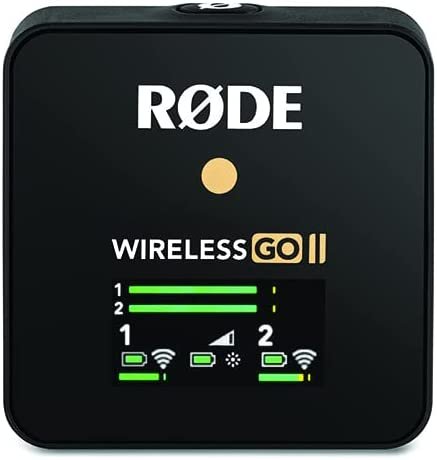
Our best and top pick for wireless best DSLR microphones in 2023, this Rode Wireless Go II is definitely worth the purchase. Without much hassles of the wires, this added microphone delivers high quality audio performance.
The Rode Wireless Go II has the newest version available in 2023, and these feature amazing sound quality, along with other added features like the Rode Central App to make the control of audio even more precise. There are also two small transmitters and and one dual-channel receiver available in this model, giving you the option to clip these transmitters, and make use of them as-is or with lavalier microphones (not included).
Not just these features, the Rode Wireless Go II has a built-in internal storage of about 40 hours of audio, including two tiny, furry, wind muffs.
Specifications
| Compatible Devices | DSLR, iPhones/Androids or any other camera having 3.5mm jack or USB-C |
| Connector Type | 3.5mm jack or USB-C |
| Power Source | Corded Electric |
| Audio Sensitivity | – |
| Polar Pattern | Omnidirectional |
Pros and Cons
Final Thoughts
In a nutshell, having a decent DSLR microphone for your equally compatible DSLR camera is bound to add a different charm and light to the videos you take for sure. But, it is important, however, to understand that all the microphones aren’t the best suited ones for your DSLR camera, and you should pair your camera with the one that reduces as much background noises as possible to make the audio quality sound crisp and clean. The best DSLR microphones in the market are categorized on the basis of different aspects and in this article, we handpicked the best ones from almost all categories of microphone usage in action cameras like vlogging, commentary, podcasts, media production, and so on.
If you have any questions or concerns about the top DSLR microphones in 2023, please feel free to leave a comment and we will be happy to assist you. Thank you for reading and we hope this article was helpful.
Related: best action camera microphone attachments
Frequently Asked Questions (FAQs)
How do I connect microphone to my DSLR?
Oftentimes, shotgun mics come equipped with a 3.5mm (1/8”) connection jack, which is a standard connection size, the same as most headphones. The procedure is similar in case of XLR connection too.
For this you have to first mount the camera securely, locate the port, push the jack from the microphone into the port, and turn the on-switch if your camera has one. Some DSLR cameras will automatically detect the jack, while some have to be turned on manually.
How do I connect a USB mic to my DSLR?
Connecting the DSLR microphones via a USB port is also fairly easy. First of all, you have to ensure that the USB mics have a headphone output. After that, you will require a USB cable that must have come with the USB mic. A laptop or a computer is also required. Then, with the 3.5mm male-to-male cable, you can make a connection, between the headphone port and the microphone.
How do I connect a wireless mic to my DSLR?
Wireless mics usually have two components- one that clips to the receiver and the next that connects to the camera.
For this, after mounting the camera securely, connect the receiver to the 3.5mm port then you have to make sure both the receiver and the transmitter unit are turned on.

